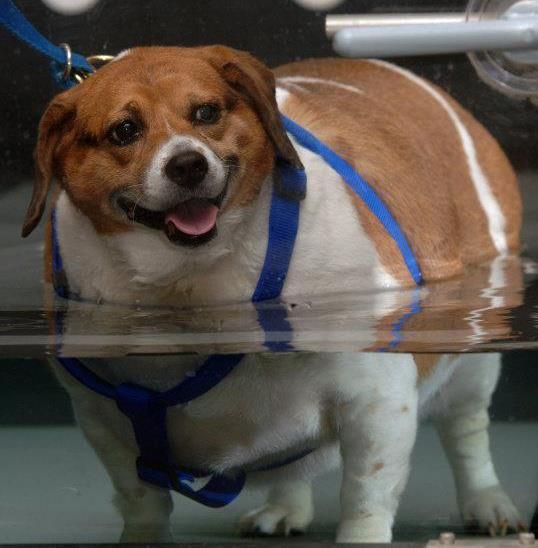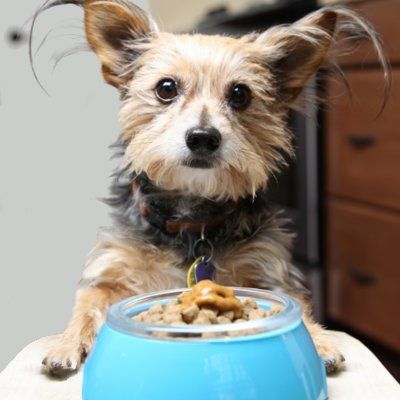By Brad Kloza for The Dog Daily
 According to the Association for Pet Obesity Prevention, an estimated 45 percent of all dogs in the U.S. are overweight or obese. Luckily, there are food choices, based on good science, that can help treat the problem of an overweight or underweight dog. Fat Dog, Skinny Dog For many dog owners, determining what’s over or under a normal weight isn’t so obvious. The most reliable way to find out is to ask your veterinarian, says Dr. Katy Nelson, a Virginia-based vet who has consulted on dog food nutrition matters.
According to the Association for Pet Obesity Prevention, an estimated 45 percent of all dogs in the U.S. are overweight or obese. Luckily, there are food choices, based on good science, that can help treat the problem of an overweight or underweight dog. Fat Dog, Skinny Dog For many dog owners, determining what’s over or under a normal weight isn’t so obvious. The most reliable way to find out is to ask your veterinarian, says Dr. Katy Nelson, a Virginia-based vet who has consulted on dog food nutrition matters.
Your vet will use one of two scoring systems, with a sliding scale that runs from emaciated to morbidly obese. A good at-home way to measure is to look at your dog’s ribs, says Rebecca Rose, a veterinary technician who has routinely advised pet owners about weight issues over her 23-year career. “If ribs can be seen, your dog is too thin,” she says. “If the ribs can be felt, that is optimum. If the ribs are not felt, then your dog is overweight.” Once you know your dog’s goal, there are a large number of specialized foods that can help.
Here’s a quick rundown for each situation:
Adding Weight
 Foods created specifically for underweight dogs, sometimes called “performance” foods, usually contain higher protein and fat than usual. This can help build muscle mass. They aren’t merely the doggie equivalent of Big Macs, says Nelson. They’re just much more calorically dense than other foods, allowing a dog to eat a “normal” amount but supplying it with more calories per bite.
Foods created specifically for underweight dogs, sometimes called “performance” foods, usually contain higher protein and fat than usual. This can help build muscle mass. They aren’t merely the doggie equivalent of Big Macs, says Nelson. They’re just much more calorically dense than other foods, allowing a dog to eat a “normal” amount but supplying it with more calories per bite.
Nelson believes it’s a better option than giving bigger portions of “regular” food. “If a pet becomes accustomed to eating a large amount per day, it may be more difficult to transition it [back] when it's achieved an ideal weight,” she says.
Weight Control
 Anyone who has dieted knows that, after losing weight, keeping it off can be just as hard. That’s where “weight control” foods come in (sometimes they’re also called “weight maintenance” or “weight management”). They’re used to maintain the ideal weight once it’s been achieved. “Don’t count on them to reduce your pet’s weight,” warns Nelson. “But they’re wonderful foods if your pet is where it needs to be.” She says these foods can also be used for obesity prevention -- for a dog that has the potential to become overweight, such as hypothyroid or “couch potato” dogs.
Anyone who has dieted knows that, after losing weight, keeping it off can be just as hard. That’s where “weight control” foods come in (sometimes they’re also called “weight maintenance” or “weight management”). They’re used to maintain the ideal weight once it’s been achieved. “Don’t count on them to reduce your pet’s weight,” warns Nelson. “But they’re wonderful foods if your pet is where it needs to be.” She says these foods can also be used for obesity prevention -- for a dog that has the potential to become overweight, such as hypothyroid or “couch potato” dogs.
Losing Weight
There is a wide variety of options for dogs that need to lose weight. Some of these foods are very high in fiber, since fiber makes dogs, like people, feel fuller with smaller amounts of food. But Nelson says drawbacks include the increased “output” that results from a fiber-rich diet, as well as poor coat quality. Instead, she prefers high-quality dog foods with moderate amounts of carbohydrates and protein.
“Look for products that include L-carnitine, an amino acid that helps ‘escort’ fat into cells to be burned efficiently,” says Nelson. “Also look for vitamin A -- it helps fool the brain into thinking that it’s full -- and chromium tripicolinate, another fat-burning additive.”
 But these foods alone won’t do the trick. “Portion control is the key in utilizing these scientifically engineered foods,” says Nelson. “You can have the best weight loss food on the market in your pet’s bowl, but if you’re dishing out too much of it, giving too many treats or not incorporating physical activity, your diet plan will fail.”
But these foods alone won’t do the trick. “Portion control is the key in utilizing these scientifically engineered foods,” says Nelson. “You can have the best weight loss food on the market in your pet’s bowl, but if you’re dishing out too much of it, giving too many treats or not incorporating physical activity, your diet plan will fail.”
It’s also important to know the proper definition of a “cup” of food. Rose says she’s experienced many occasions where a dog owner’s idea of a cup was way off from the official eight ounces. “Conversations around ‘cup’ varied -- that a coffee can is a cup, or a 24-ounce soda cup is a cup. Obviously, these are not true 8-ounce servings,” she says.
Lastly, you might wonder how all these foods taste. Are they as unappealing to dogs as many “diet” foods are to people? “You may have to try a few foods to find the one that your pet will like,” says Nelson. “But in general, pets that are obese often do not have the most discerning of tastes.”
Brad Kloza is a freelance writer and frequent contributor to The Dog Daily. His work has appeared in The New York Times Magazine and Discover.





